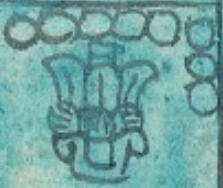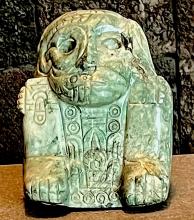Chicuei Acatl (Mdz2r)
This representation of the solar year (xihuitl) date Eight Reed (Chicuei Acatl) includes the notation for eight (chicuei) and the simplex glyph for reed/arrow (acatl). The number eight consists of two groups of circles representing five and three. The five circles are at the top, and the three on the right side, near the top right corner. These circles are empty, whereas sometimes they can have dots or smaller concentric circles in the middle, as shown below. The acatl is painted in the typical style, with the short upright reed decorated with eagle feathers and down balls (probably tlachcayotl), like the arrow (mitl). At the base of the symbol is a small representation of an apantli (canal or water ditch). The entire compound is enclosed in a black-line drawing of a box, not entirely visible in this image, and it is painted over a turquoise blue. The word for turquoise (xihuitl) is a homophone of the word for year (xihuitl). Thus, the turquoise color here serves as a phonetic indicator that this is a year date.
Stephanie Wood
A boxed-in date says this refers to a year. The calendrical acatl, at least in the Codex Mendoza, seems to be presented as an arrow with fletching, but it also grows out of a waterway. See some additional examples of acatl, below, which also connect the reed with the arrow.
The presentation of the notation, in a group of five and a group of three, is like a math equation, 5 + 3 = 8. It also echoes the language of chicuei, which combines chico- or chiuc- (five) and eyi (three). While the stand-alone number for five is macuilli, the combining form (chico, chiuc, etc.) means "on one side," and it refers to having counted the fingers on one whole hand already and then adding fingers from the other hand, the other side. See our dictionary entries for chico and chiuc-.
Stephanie Wood
c. 1541, or by 1553 at the latest
Stephanie Wood
dates, fechas, ones, numbers, números, years, años, reeds, cañas, plumas, feathers, canales, calendario, plantas, flechas, xiuhpohualli, turquesa, xihuitl
The date of Chicuei Acatl appears here on a small figure in the Museo Nacional de Antropología e Historia, Salón Mexica. Signage describes the piece as depicting the "duality of dry and rainy seasons" of the "indigenous agricultural cycle." Aside from the date glyph, the figure has its face "covered on one half with a serpent mask, associated with Tlaloc, the rain, and the other only its skin, which signals the dry season." Photograph by Robert Haskett, 14 February 2023.

chicuei, eight, https://nahuatl.wired-humanities.org/content/chicueichiucnahui, nine, https://nahuatl.wired-humanities.org/content/chiucnahui
chiuc-, five in number combinations, https://nahuatl.wired-humanities.org/content/chiuc
chico, five in number combinations, https://nahuatl.wired-humanities.org/content/chico
aca(tl), a reed or cane, https://nahuatl.wired-humanities.org/content/acatl
Ocho Caña
Stephanie Wood
Codex Mendoza, folio 02 recto, https://digital.bodleian.ox.ac.uk/objects/2fea788e-2aa2-4f08-b6d9-648c00..., image 14 of 188.
The Bodleian Libraries, University of Oxford, hold the original manuscript, the MS. Arch. Selden. A. 1. This image is published here under the UK Creative Commons, “Attribution-NonCommercial-ShareAlike 3.0 License” (CC-BY-NC-SA 3.0).







